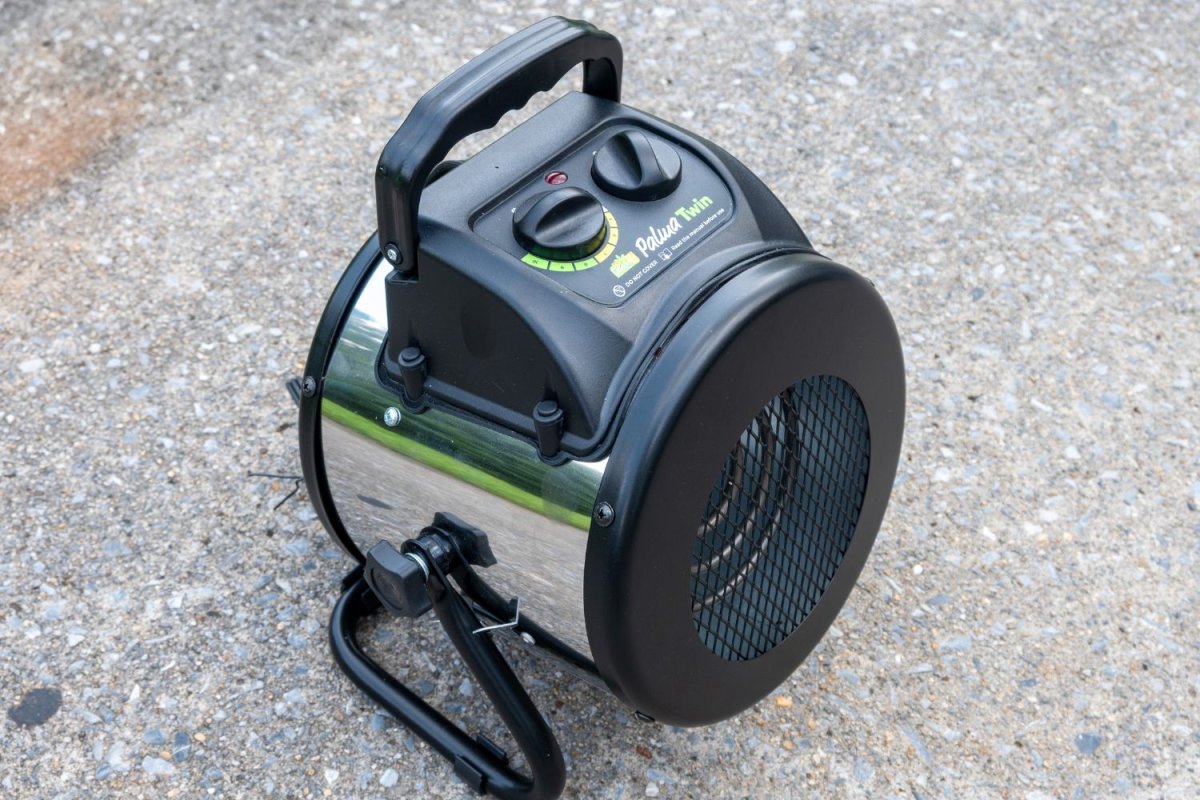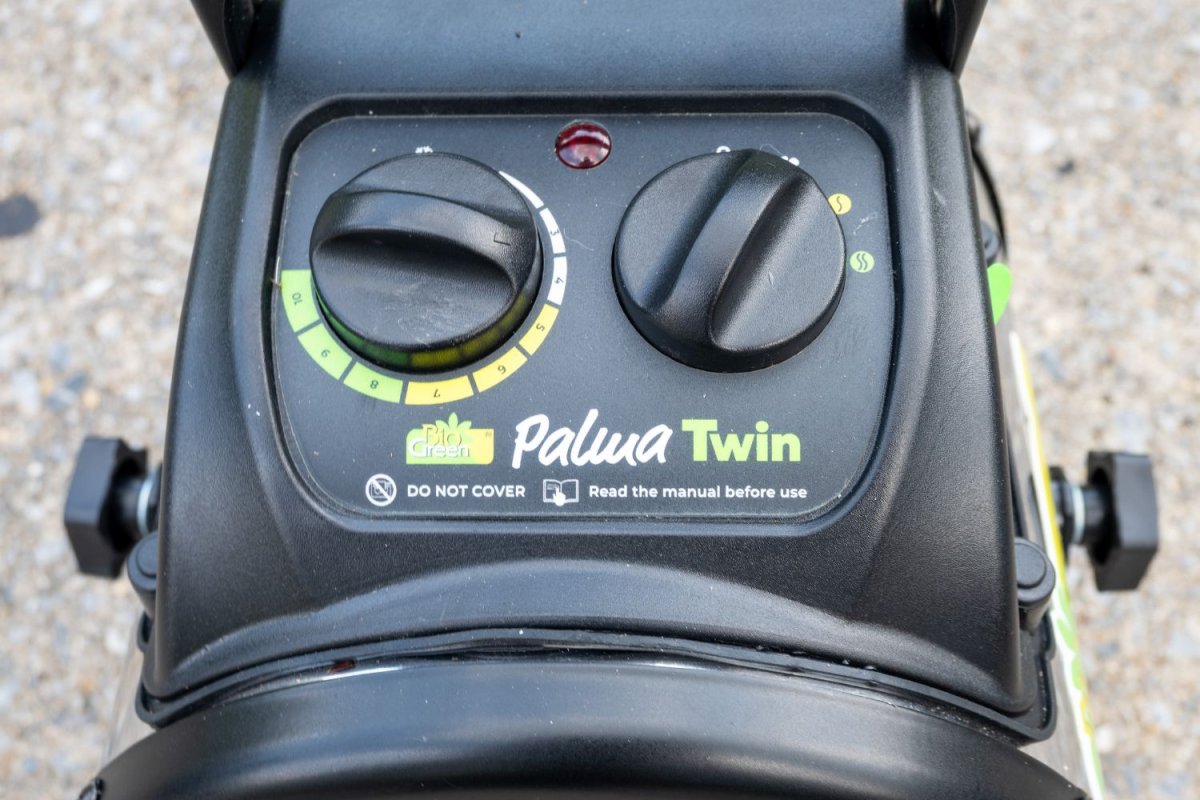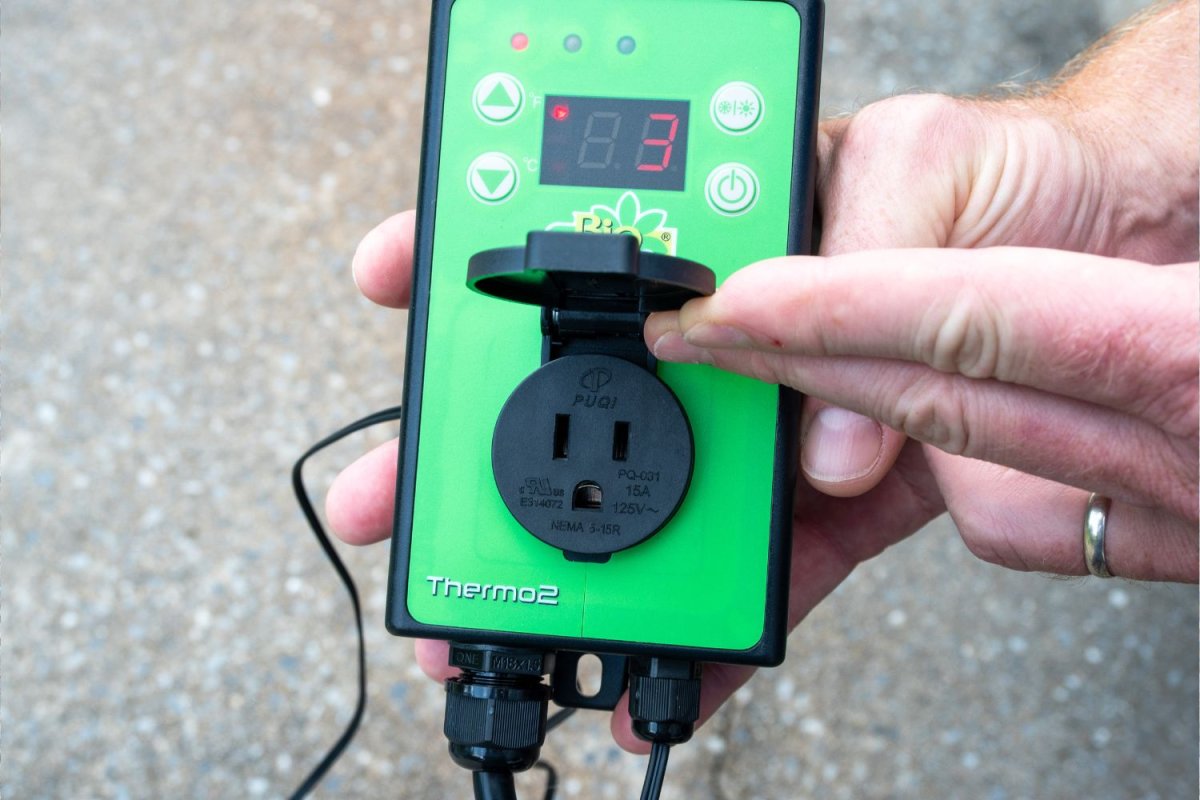
We may earn revenue from the products available on this page and participate in affiliate programs. Learn More ›
Bio Green Palma 110V Greenhouse Heater: At a Glance
Rating: 4.8/5
Pure sunshine can warm an unheated greenhouse in the middle of winter, but without a greenhouse heater, it gets frigid when the sun goes down. Whether it’s for overwintering tender potted plants or starting seedlings before the last frost date, the heater feature makes the structure fully functional. And it doesn’t take much to get the job done. I tested the portable electric Bio Green Palma Heater in my little backyard greenhouse, and it had no trouble keeping the inside temperature up to 30 degrees Fahrenheit warmer than the air outside.
Bio Green offers an array of innovative garden products, from greenhouse heaters, lighting, and accessories to raised beds, tarps, and watering tools. The company prides itself on delivering high-quality products to its worldwide customer base. The Palma heater was ideal in my situation, but it may not be the right choice for every customer. In this review, I’ll share my observations from 4 weeks of testing, including why it excelled for me and where I think it might not get the job done.
| What We Like | What We Don’t Like |
| Compact, portable heater | Relatively short 6-foot power cord |
| IPX4 splash-proof rating | |
| Low and high power heating options | |
| Built-in circulation fan | |
| External digital thermostat | |
| Heats up to 130 square feet |
| Bio Green Palma Heater Specs | |
| Heating power | 5,120 British thermal units (BTUs) |
| Air circulation | 5,756 cubic feet per hour |
| Weight | 4.5 pounds |
| Dimensions | 11 inches tall by 8 inches wide by 12.5 inches deep |
Testing the Bio Green Palma 110V Greenhouse Heater
As our product reviews team began research for a guide to the best greenhouse heaters, one model came up with positive reviews time and again: the Bio Green Palma 110V greenhouse heater. The no-frills 1,500-watt heater offers low and high heat settings and an adjustable onboard thermostat. It doesn’t look much different from any other electric space heater, but it includes a few key features that make it ideal for heating a greenhouse, including an IPX4 splash-proof rating, automatic tip-over shutoff, and a rugged stainless steel housing. It also has a fold-down carry handle on top and a sturdy slip-resistant base.
I have used a 1,500-watt space heater to keep my 80-square-foot greenhouse warm through the past five winters, but this was my first time using a Bio Green heater. I liked the Palma’s low stance and compact size, which allowed it to emit warm air closer to floor level, and its built-in ability to circulate the air and eliminate cold pockets. The supplemental digital thermostat is arguably the best feature. Mounting it at plant height made temperature control much more accurate than my previous system. After a month of testing, it far surpassed the heating consistency and accuracy that other heaters delivered.

Works for a Small Greenhouse
A quick look at the specs reveals that the Palma Heater tops out at about 5,120 BTUs of heat output, and its fan pushes 5,756 cubic feet of air per hour. That’s enough heat for a 130-square-foot room. But since greenhouses are not as well insulated, it is probably best for about 96 square feet (12 feet long by 8 feet wide) under a well-sealed plastic, polycarbonate, or glass greenhouse covering.
That being said, I live in Georgia. Our coldest winter temperatures rarely dip below 20 degrees Fahrenheit, and I keep the greenhouse thermostat at 40 degrees Fahrenheit. In testing, I monitored the heater for 3 hours while maintaining the temperature 20 degrees Fahrenheit higher than outside, and it did great. I’m confident that it could do 30 degrees Fahrenheit in my situation, but that’s without wind and with a loaded greenhouse (lots of thermal mass to help reduce temperature swings). If you require a warmer greenhouse, or if your area gets much colder than mine, one of these heaters may not be enough.
Easy to Operate
It really is easy to set up and operate. The Bio Green Palma heater is plug, plug, and play. First, plug the thermostat into a wall outlet, make sure it is set to control heating instead of cooling, and set the target temperature. Then plug the power cord from the heater into the outlet on the face of the thermostat. Make sure the heater’s onboard thermostat is turned to the highest setting. Turn the fan/low/high selector to the desired setting, and you’re all set.
In this configuration, the supplemental thermostat switches the heater “on” when the actual temperature drops below the target temperature. Then, when the temperature rises to the target, it switches the heater “off.” It is also possible to simply plug the heater into the wall outlet and use a thermometer to calibrate the onboard thermostat, but that was less accurate when it came to controlling the temperature at plant height. Since the temperature sensor on the supplemental thermostat is connected by a 10-foot lead, I can position it anywhere in the greenhouse.
Great at Heating and Maintaining Temperatures
I tested the heater for its ability to raise the temperature of a cool space by 20 degrees Fahrenheit and for its ability to maintain the target temperature over time. It took 14 minutes to thoroughly warm the space to our target temperature. After reaching the target, the heater cycled on and off at regular intervals, running not more than 2 minutes at a time.
It’s important to strategically place the thermostat sensor with respect to the warm airflow emitting from the face of the heater. If the sensor is too close to the direct path of heated air, it will turn off the heater prematurely. I had good results with the heater facing the greenhouse door while the sensor was suspended at bench height at the opposite end of the greenhouse.
Is the Bio Green Palma heater worth the money?
The Bio Green Palma heater costs more than average, even considering that it comes with an external digital thermostat outlet. Similar thermostats sell for between $20 and $30, while 1,500-watt space heaters run as low as $20. So, on the cheap end, you could buy components for about one-fifth of the price. But the details matter.
In a greenhouse setting, the IPX4 splash-proof rating is a matter of personal safety and longevity of the equipment. Cheap heaters do not offer that peace of mind. Also, the steel housing and stand is better suited to the greenhouse environment than plastic. While the price may be a bit higher than some similar models out there, the price-to-quality ratio is not out of line. Bottom line: It’s worth the money.

Should you buy the Bio Green Palma heater?
If you have a greenhouse, you need a greenhouse heater to make it fully functional. There are different types available, including gas and electric options, with built-in and portable models in both categories. Before making a life-or-death decision for your plant collection, understand that portable electric heater output is limited. To achieve a springlike growing environment in a deep-cold climate, even in a small greenhouse, the Palma heater may not be enough. Tropical plants need to stay above 50 degrees Fahrenheit, and this heater can only sustain 20 to 30 degrees Fahrenheit above the outdoor temperature. For more heating capacity, consider gas heat or a hardwired electric system.
But there are plenty of scenarios when a plus 20- or 30-degree Fahrenheit temperature difference solves the problem at hand. For instance, I need a relatively cool greenhouse to keep marginally hardy plants alive through the winter. And when it comes to seed starting ahead of spring planting, this little heater puts out plenty of warmth. The Bio Green Palma 110V greenhouse heater proved capable of raising the air temperature quickly and holding the target temperature consistently. It was easy to operate, had a durable build, and the price was right. For most small backyard greenhouses, one or two of these heaters could be the best heating option out there.
Meet the Tester
Mark Wolfe is a writer and product tester with an extensive background in the nursery and landscaping industry. For more than 20 years he mowed, edged, planted, pruned, cultivated, irrigated, and renovated beautiful landscapes. Now he tests and writes reviews about the latest outdoor power equipment, hand tools, lawn care products, and other outdoor living goods.
